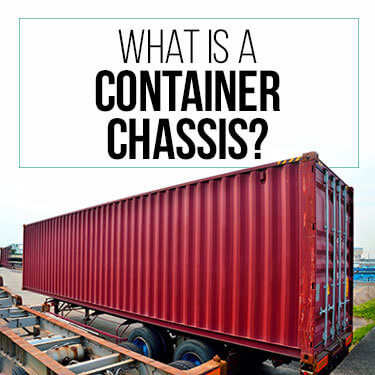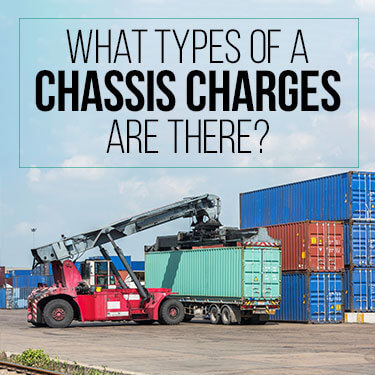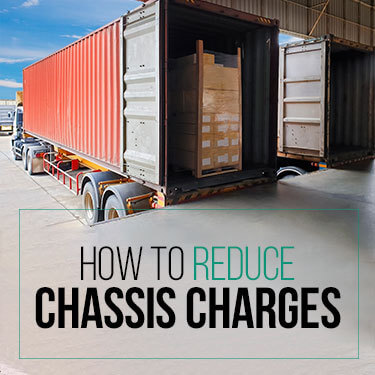Excellent working knowledge of what a chassis is and what related charges are can help you along the way when shipping. Chassis costs are not a cut and dry topic by any stretch of the imagination. Multiple factors and situations can influence the rise and fall of chassis charges.
Chassis fees are calculated after your container is loaded onto a chassis. For example, a twenty-foot shipping container loaded onto a two-axle chassis will run roughly $35-40 a day. This guide will offer expert advice on the following information:
The following information will give insight into chassis utilization charges, related charges, and the varied types of chassis available.
Have you ever heard the term tractor-trailer? A chassis is a uniquely designed trailer that carries shipping containers from an ocean port to their final destination. The term refers to the chassis as the trailer and the truck as the tractor. A chassis charge applies when your cargo gets transported to either drayage or a warehouse from an ocean port.
The chassis charge is a flat rate applied by port rentals, drayage pool rentals, or a carrier/3PL. Drayage has become the desired solution for chassis shipping from the ports. This preference is due to the demand for shipping containers and the lack of available chassis.
More often than not, chassis fees can become confusing. Before 2009, there were provisioned chassis at the ports by ocean carriers. Unfortunately, this is no longer the case. Now you must purchase or lease chassis equipment, which forced most drayage companies or carriers to use their equipment.
If you are using a drayage service, there are a few options for getting the container or its contents to the final destination. At the same time, get the container back to the port as soon as possible. You can also rent chassis from nearby chassis pools and rail ramps.
Outside factors such as a busy shipping season or catastrophic weather conditions are normal circumstances. However, currently, the world finds itself under the conditions of a global pandemic and an economic recession.
The lack of normal production worldwide has impacted supply chains and consumers. How has the COVID-19 pandemic & economic recession caused supply chain disruptions?
The U.S. government also noticed the pandemic's impact on manufacturing and supply chains. The President signed an executive order to review American production capacity and ensure the availability of critical goods via supply chains.

Container chassis is the frame and set of wheels containers attached to transport cargo. Chassis are uniquely designed and reinforced for the loading and offloading done by cranes. The chassis design includes locking mechanisms to secure the containers to the chassis for short or long hauls.
Some chassis are designed for heavier weights, have three axles, and are not as common as the two-axle configuration. All chassis inspections happen before leaving a transload terminal or port. Inspections ensure that the tires are safe, brakes work, lights work, and the overall condition of the chassis is road safe.
Shipping containers come in several sizes; the most common sizes are twenty feet and forty feet for international shipping configurations. Other options include the forty-five and fifty-three-foot containers, often used in intermodal drayage.
The twenty-foot containers carry heavy, dense cargo that will typically weigh out before additional volume is needed. These containers usually hold bulk commodities, machinery, or metals. The forty-foot container is the most common container used internationally. These forty-foot containers carry general goods or merchandise.
The forty-five and fifty-three-foot containers design is for shipping more volume with fewer containers. However, as mentioned earlier, forty-five and fifty-three-foot containers are used from drayage locations. These containers have practical applications in both transload and cross-docking operations.
Since there are multiple shipping container dimensions, there must be varied chassis to haul them. Some of the different types of chassis outlined here have specific use cases for short-haul and some for long-haul situations.

Containers transported via chassis can quickly become an expensive ordeal. Various charges are applied when utilizing a container chassis, from chassis rentals to the multiple individual costs that stack up. It is important to note what these charges are and whether or not they are avoidable or negotiable.
One form of a chassis charge is chassis rental directly from the port. You can rent various chassis types, like a twenty-foot chassis with two or three axles. The rental fee associated with a chassis may not look like much at first glance. However, the charge can morph into a much larger number at a second glance.
| The Number of Axles | Daily Charge Amount |
| Two Axles | $40.00 daily |
| Three Axles | $80.00 daily |
The process from the beginning and final destination often is a lengthy one. The average amount of time renting the chassis is five days. Unfortunately, chassis rentals from a chassis pool, rail terminal, or a 3rd party carrier can take up to a week to secure.
| The Number of Axles | Five Day Charge Amount |
| Two Axle | $200.00 weekly charge |
| Three Axle | $400.00 weekly charge |
Some third-party carriers also rent their chassis to shippers, and they do so typically at a more expensive rate. However, during the busy season or when there is congestion, the port does not have enough chassis to rent. A carrier rental might be the only option when this disruption happens at the ports.
The chassis usage fee is different depending on the carrier you choose to go with at that time. Also, the cost will vary depending on the port or rail yard you are operating within. It is important to note that some carriers may also impose additional fees on top of the standard usage fee if they apply. Some examples of additional outlier fees would be that of detention and provision.
The term tri-axle means three axles on the chassis. The reason for three axles on a chassis is to increase the load-bearing weight that is safe for a chassis to transport. In some cases, the third axle is air-lift to carry larger loads safely.
In some cases, tri-axle fees apply if the weight of the load is more significant than expected. In this particular case, the use of a tri-axle chassis has to meet the requirements of the law. While additional fees for using a tri-axle chassis accumulate and pass on to the shipper.
A chassis split happens when the shipping container is in a different location than the chassis. When this happens, the shipper will get a split charge to cover the cost of getting the chassis to the container's location. In this circumstance, a chassis split often will delay the shipment from arriving at its final destination.
The chassis split charge gets applied when the container is delivered. If this is a rented chassis and not a carrier chassis, a predetermined chassis pool will dictate and manage the pickup and termination point for all chassis rented. They will also work with rail ramps and port terminals regarding chassis availability.
This charge occurs when a shipper cannot accept the delivery before the last available free day. The term "free day" refers to the last remaining day in which the cargo transportation does not accrue additional charges.
If there is poor communication, designated delivery dates will fail to meet an appointment. In some cases, a container that arrives early will route to a container yard until the predetermined delivery appointment.
The same rule would apply if the shipment comes in before a weekend or a holiday and the shipper cannot accept it until the following Monday. This mishap will garner a pre-pull charge, about one-third of the cost of paying total storage fees on average.
The reposition charge, aka repo charge, is the direct cost for moving empty cargo containers to the closest hub via chassis. The reason for moving containers at the port is to keep as many containers available and ready for use.
If the cargo container is not empty, a chassis split charge will access along with the repo charge. Again, this is a scenario where good communication will prevent unnecessary fees from stacking onto your shipment. Conducting some due diligence with the load will be the most significant cost-saving measure in the grand scheme of things.
These charges get calculated by combining the total charges from when a container chassis is picked up and returned. Whether renting a chassis, using a carrier or 3PL, or a drayage service, the number of charges adds up.
There is no absolute set number for chassis fees or any associated charge. Depending on the chassis pool, rail ramp, or carrier/3PL, these charges will vary.

When considering reducing charges related to using a chassis, awareness of potential savings is essential. There are four topics to consider when trying to minimize chassis fees. These topics will apply in most if not all cases, so it is critical to familiarize yourself with them.
Negotiating and using a 3PL can bring in a reduced chassis cost. Like renting a chassis from a pool or carrier, avoiding nighttime or weekend pickups is a sure-fire way to save money as it relates to renting a chassis.
One of the ways you can save money on chassis is through future technologies that could prove to become cost-saving through energy efficiency. The new Tesla Semi is trying to set a new standard in eclectic semi chassis transport.
Many carriers have announced plans to deploy electric trucks like the new "Tesla Truck" on short-haul drayage runs, which typically do not exceed 150 miles. This plan is a fantastic fit for early model electric trucks to grasp short-haul trucking before diving into long-haul trucking.
The new Tesla Semi has a max distance of five hundred miles under max load at highway speeds. Most routes are two hundred and fifty miles, meaning they can deliver a load and return on a single charge.
Dealing with container chassis can be a very costly and aggravating affair. The global pandemic has caused significant problems with international shipping and distribution. Disruptions in the supply chain have created a severe bottleneck at coastal ports.
USA Truckload powered by R+L Global Logistics is ready to provide you with best-in-class shipping solutions. Our friendly experts can get you set up with a quality chassis on time. While getting your shipping containers out of the port quickly and without accruing unnecessary chassis fees. Call us at (866) 353-7178, or let us handle the hassle of port drayage for you today.
R+L Global Logistics
315 NE 14th St., Ocala, FL 34470